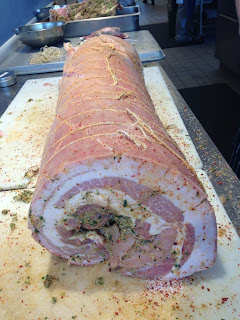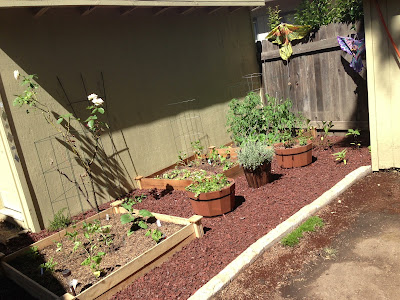 |
| When is an omelette not an omelette? |
Most who know me know that my times living in Spain have done a lot to shape who I am as a person, and as a cook. Amidst the culture, the architecture, the smells on the streets, and the feel of the land, I have always been able to feel a sense of home in Spain, for no other reason than a genuine connection with the place and the people. I can specifically recall being on the train from Madrid to San Sebastian in 2009, my most recent stint as a temporary Spaniard, rolling through the tranquil countryside. Its tall, narrow trees, scattered about the gray and golden plains, inexplicably felt like home, calming the waves of jet-lag and nervousness rolling through my belly for the adventure ahead of me. Speaking the language has certainly greased the wheels when it has come to immersing myself in the culture, but so has my love of Spanish cuisine, which stems from a number of factors.
First off, Spain embraces the rustic in a way all their own. Italy is often hailed as the ideal paradigm of rustic cuisine, elevated in its flavor and process if not in the labor of its presentation. But I ask you to show me a greater commitment to the rustic approach than having the entire leg of a pig, complete with shiny hoof, perfectly preserved and sitting on your breakfast table twenty-four hours a day with a knife beside it, available for slicing off a Scooby snack whenever the mood should strike. For heaven's sake, who needs a fruit bowl, right?!
 |
| Jamon Iberico, where it belongs: on a pedestal. |
What's that? Game of Thrones is on? Hold on, let me just slice a hunk of this incredibly complex and delicious ham from the large, expertly cured body part in the other room!
I know, it sounds like heaven to me too.
Then there's paella. Do I even need to say anything about paella? Because I'm going to. This wonderfully non-kosher concoction embodies the Spanish spirit of community and improvisation centered around cooperation, tradition, love, and celebration. When I lived with the Doncel family in Segovia all those years ago, I would spend Sundays in the country with them while my friends played football in the fields beside the local castle and got drunk. Being fifteen, I sulked at first to be taken from my friends, but eventually I began to appreciate the ritual of what we were doing. We would drive to a meadow beside a stream where we would meet up with a number of other families, each bringing their own ingredient to the pool. I guess you might call it sort of a 'paella-luck.' (Cue el rimshot, por favor.)
 |
| Best jacuzzi ever? |
The socarrat seems, to me, to exemplify the Spanish rustic ideal in culture as well as cuisine. For those who aren't familiar, I'm referring to the layer of rice at the bottom of the pan that gets crispy, almost forming an upside down shell around the rest of the paella. This layer is tough to get perfect, especially in big batches, so naturally, you end up with patches here and there that may have a little char; but do you think that matters to anyone watching a beautiful, glistening mound of paella being piled onto his plate? The socarrat provides texture in the paella, and of course, concentrated flavor. As with coal in the layers of our earth, flavors get impressed and compressed and intensified in the socarrat; it's rich with the story of the paella. It is also, in simplest terms, crispy, fatty rice, bursting with flavor, under many kinds of meat and seafood. It may not be ostensibly sexy, but one bite and you understand. Paella, as a whole, is the bringing together of things slowly and deliberately to yield a result rich with flavor and character that may not always be obvious at first glance. To me, this is a big reason the dish is so emblematic of Spain's traditional cuisine.
 |
| Paella, brought to you by the entire cast of The Little Mermaid. |
And of course, the dish that brought me here to write in the first place: Tortilla. Tortilla holds the place most special in my heart of any traditional dish in Spanish cuisine, because it is the one that stood by me through thick and thin; it was present and influential in each time I lived in Spain, apropos both my day-to-day life and my identity as a chef. The first time lived in the country, in 1996, my home was the miniscule town of Segovia, a picturesque Spanish puebla somewhat stuck in time, complete with aqueduct and local castle. Its cobblestone streets provided a pleasant walk to school each morning, filled with sounds and smells and sights that showed an authentic side of Spain not all visitors get to see. But Segovia's streets also introduced me to bocadillo de tortilla: an egg, potato, and onion omelette on soft, white French bread. Simple; delicious; Spanish.
 |
| When eggs and toast get frisky... |
Belly growling by sundown, I would hustle to the closest sandwich stand on my way out to meet up with my friends and grab a bocadillo de tortilla for dinner. The beautifully simple combination of bread, eggs, potatoes, and onions does extremely well to satisfy one's hunger; it's also a swell combination of protein and carbohydrates, well-equipped to handle a fifteen-year-old learning to drink on sangria. Tortilla Espanola got to know me better in Spain that summer than any classmate or teacher, and I developed an appreciation for it; such a simple dish allows for little variation from shop to shop, but then it's that much easier to appreciate subtle differences.
 |
| Pre-tortilla: not exactly thrilling... |
More recently, however, my hometown in Spain was Lassarte-Oria, a suburb a few miles outside the surfer's paradise of San Sebastian, in the thick of Basque country and a stone's throw from Bordeaux. My ticket to Spain this time was a three month stint at trip-Michelin Restaurante Martin Berasategui. For those of you out there who have been reading Tasty Morsels since the beginning, we have come full circle: my stage at Martin was the very reason I started this blog in the first place, the first post written the evening before I left for Spain. For what it's worth.
The restaurant's kitchen was staffed by a team of more than 60 cooks, run in a military style, with a a division of all labor dispersed among the various crews. One of the responsibilities that fell to my crew's section of the kitchen was preparing staff meal on certain nights; once a week, that meant making Tortilla. Nothing went without saying in Martin's kitchen, so I received plenty of instruction on how to properly cook the dish to its authentic correctness. Over the course of my time there, I became fluent in the technique and nuances of its preparation, learning and paying attention to the genuine article.
Between my clockwork communion of Tortilla as a hungry teenager in Segovia, and my clockwork instruction on its method as a passionate cook in Lasarte, you can see why Tortilla is both emblematic and important to me. As a cook, a former vegetarian, a lover of Spanish food and culture, and a connoisseur of simple pleasures, the connection is complex and the fondness great. But since returning to California, I have inevitably spent time perfecting my own version of Tortilla, one that I feel is true to its soul, but indubitably improves upon its greatness. You see, to go wild and make drastic changes to the dish would be to go against part of what makes it intrinsically Spanish: a few, simple ingredients, prepared with love, not particularly dressed up or in your face. How, then, does one maintain those ideals while still managing to elevate? Such is the truest, hardest work of a chef: to make something your own while allowing it to keep its cultural and culinary identity.
For me, and more specifically, for my version of tortilla, my changes and additions are slight and simple, yet they make a huge difference and can really blow up your palate. In this way, my own version seems to celebrate the very spirit of Tortilla, in itself. To begin, I like to use a cast iron pan, specifically for what it can do to potatoes and onions in the right hands; and my hands happen to be the right hands. I start by getting the onions significantly browner than one would in traditional Tortilla; this helps them release more sweetness and moisture into the dish as a whole. I take them toward their soft stage, still leaving some texture and bite, then add a little bit of butter. Next come the potatoes, which I also get nice and brown, taking them just to the point that they start to get crispy, but not beyond. The only way to really get things to that perfect point is to stand at the stove pretty much the whole time: watching, listening, observing for the key moments to stir and season; that's when the looooove goes in. Finish things off with a handful of fresh thyme, then come the eggs, salt and pepper. I let it brown just a tiny bit on the burner, and then into the oven it goes.
The resulting Tortilla has a particularly earthy sweetness complemented by well-seasoned potatoes, against a soft background of fragrant thyme. The addition of thyme adds something special, and though it's not a traditionally Spanish move, it is also one of the most simple and all-purpose of fragrant herbs, which is why I use it. To go with rosemary or tarragon or something like that would certainly be tasty, but its alteration would be more drastic than thyme, which folds well into the flavors without taking center stage. And as far as the onions and potatoes, the twist of caramelization is merely an addition of love and time, which can only improve a dish. I feel that, in food and in life, building on tradition is as important as preserving it. Cuisine and culture are living entities, and to let them stop changing and growing is to stop growing as a person, whether that person is a chef or a pediatrician or a firefighter.
So now you know all abut my love affair with Tortilla Espanola. A faithful mistress, and one that I continue to hold dear to my heart (and stomach), she has been many things for me: a suppertime savior, a culinary instructor, a crowd-pleaser, and a comfort. As long as I cook, the dish will be one of my signatures, a great source of inspiration, as well as pride. I dare say it holds the same importance for Spain.


























